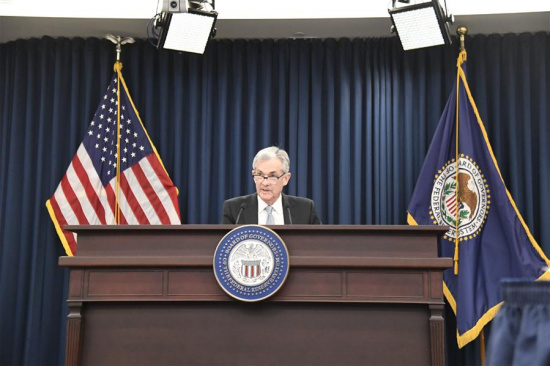 U.S. Federal Reserve Chair Jerome Powell speaks during a news conference in Washington D.C., the United States, on March 21, 2018. The U.S. Federal Reserve on Wednesday raised the benchmark interest rate by 25 basis points, its first rate hike in 2018. (Xinhua/Yang Chenglin) The U.S. Federal Reserve on Wednesday raised the benchmark interest rate by 25 basis points and signaled two more rate hikes in 2018, citing "strengthened" economic outlook in recent months. "In view of realized and expected labor market conditions and inflation," the Fed decided to raise the target range for the federal funds rate to 1.5 to 1.75 percent, the central bank said in a statement after concluding a two-day meeting. Fed officials widely expected that the U.S. economy would grow at a faster pace this and next year, driven by fiscal stimulus and improved overseas demands. The U.S. economy will grow at 2.7 percent in 2018 and 2.4 percent in 2019, higher than previous projections of 2.5 percent and 2.1 percent, respectively, according to the Fed's forecasts released on Wednesday. Fed officials also expected core inflation to rise to 2.1 percent next year, slightly above the Fed's target and up from an earlier projection of 2 percent. The unemployment rate is estimated to fall to 3.8 percent in 2018 and 3.6 percent in 2019, both below the previous projections of 3.9 percent. Fed policymakers still envisioned three rate hikes in 2018 despite of improved economic outlook, according to the median forecast for interest rates. But Fed officials penciled three rate increases in 2019 and two in 2020, more than previously estimated in December. However, Fed Chairman Jerome Powell downplayed the significance of these interest rate forecasts, declining to acknowledge that the central bank would pursue a faster pace of tightening. "I think like any set of forecasts, those forecasts will change over time. They will change depending on the way the outlook for the economy changes," Powell said at a press conference after the meeting. "If the economy is stronger or weaker, the path could be a little less gradual or a little more gradual," he said. Wednesday's announcement marked the Fed's sixth rate hike since late 2015 and the first move under Powell, who took the helm of the central bank in February. |
Powered by Discuz! X3.4
© 2001-2013 Comsenz Inc.